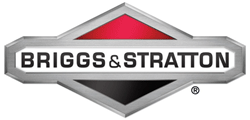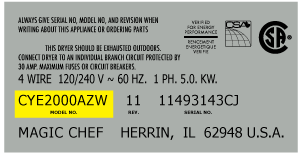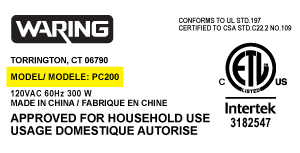TAWS800JQ0 Estate Washer - Instructions
Keep searches simple. Use keywords, e.g. "leaking", "pump", "broken" or "fit".
No movement from Basket & agitator
The job looked intimidating but turned out to be very easy.
First take off the water pump by removing the two clips that hold it in place. Place a shallow pan under the pump to catch the water that is in the pump and hoses. Open the hose clamps with a pair of pliers or channel locks (better) and slide the hoses off of the water pump.
The motor comes off next. Unplug the electrical connector from the motor and two wires from the capacitor. Remove the two screws holding the clamps in place and then pop off the two clamps. You will need to hold up the motor with one hand while you remove the clamps or it will fall to the floor once the clamps are removed.
One piece of the coupling assemble will be attached to the motor and the other will be attached to the gearcase drive shaft. If you want to clean up the mess created by the shredded rubber center piece of the coupling assembly you will have to take off the motor mounting plate. It is held on by two bolts and removing it makes installing the coupling easier but probably not necessary.
Push the back half of the coupling on to the gearcase drive shaft until the shaft is flush with the face of the coupling. Install the new rubber center piece on to the coupling then re-install the motor mounting plate. Install the other half of the coupling on to the motor shaft and lift the motor up to the coupling. You have to rotate the motor shaft by spinning the fan blades until the coupling lines up so you can slide it into the other half of the coupling. Then just reattach the motor, connectors and water pump in the reverse order of disassembly.
First take off the water pump by removing the two clips that hold it in place. Place a shallow pan under the pump to catch the water that is in the pump and hoses. Open the hose clamps with a pair of pliers or channel locks (better) and slide the hoses off of the water pump.
The motor comes off next. Unplug the electrical connector from the motor and two wires from the capacitor. Remove the two screws holding the clamps in place and then pop off the two clamps. You will need to hold up the motor with one hand while you remove the clamps or it will fall to the floor once the clamps are removed.
One piece of the coupling assemble will be attached to the motor and the other will be attached to the gearcase drive shaft. If you want to clean up the mess created by the shredded rubber center piece of the coupling assembly you will have to take off the motor mounting plate. It is held on by two bolts and removing it makes installing the coupling easier but probably not necessary.
Push the back half of the coupling on to the gearcase drive shaft until the shaft is flush with the face of the coupling. Install the new rubber center piece on to the coupling then re-install the motor mounting plate. Install the other half of the coupling on to the motor shaft and lift the motor up to the coupling. You have to rotate the motor shaft by spinning the fan blades until the coupling lines up so you can slide it into the other half of the coupling. Then just reattach the motor, connectors and water pump in the reverse order of disassembly.
Parts Used:
-
Jeff from Wayne, NJ
-
Difficulty Level:Easy
-
Total Repair Time:30 - 60 mins
-
Tools:Pliers, Screw drivers, Socket set
1113 of 1207 people
found this instruction helpful.
Was this instruction helpful to you?
Thank you for voting!
Washer stopped mid cycle
1. Unplug washer.
2. Remove screws at control panel end caps.
3. Flip control panel back to expose wiring.
4. Detach lid switch wiring harness from control panel.
5. Use screwdriver to pry the 2 brass clips holding the back panel of the washer to the front and sides piece.
6. Tilt the front/sides piece over to expose lid switch.
7. Use nutdriver to detach ground wire.
8. Use screwdriver to remove 2 screws holding lid switch in place.
9. Install new lid switch. Make sure wiring harness piece is facing the right direction.
10. Put washer back together in same order it was disassembled. Make sure front/sides piece connects to the clips at the bottom.
2. Remove screws at control panel end caps.
3. Flip control panel back to expose wiring.
4. Detach lid switch wiring harness from control panel.
5. Use screwdriver to pry the 2 brass clips holding the back panel of the washer to the front and sides piece.
6. Tilt the front/sides piece over to expose lid switch.
7. Use nutdriver to detach ground wire.
8. Use screwdriver to remove 2 screws holding lid switch in place.
9. Install new lid switch. Make sure wiring harness piece is facing the right direction.
10. Put washer back together in same order it was disassembled. Make sure front/sides piece connects to the clips at the bottom.
Parts Used:
-
Travis from Pearland, TX
-
Difficulty Level:Easy
-
Total Repair Time:15 - 30 mins
-
Tools:Nutdriver, Screw drivers
1019 of 1045 people
found this instruction helpful.
Was this instruction helpful to you?
Thank you for voting!
washer wouldn't agitate
First pry off the cap of the agitator. Then using a socket remove the bolt that holds the plastic cup in place. Remove this cup by prying it loose from the two tabs that hold it in place. Once this cup is removed you can get to the broken cogs.
Slip the new cogs into the underside of the cup, and slide the cup back down in the agitator housing using the slots on the side for a guide. (You may want to remove the entire agitator and assemble everything upside down, then flip it all back over to mount, so the cogs don't fall out).
Tighten the bolt, snap the cap back in place on top of the agitator and your'e done. Easy repair.
Slip the new cogs into the underside of the cup, and slide the cup back down in the agitator housing using the slots on the side for a guide. (You may want to remove the entire agitator and assemble everything upside down, then flip it all back over to mount, so the cogs don't fall out).
Tighten the bolt, snap the cap back in place on top of the agitator and your'e done. Easy repair.
Parts Used:
-
mike from Kent, WA
-
Difficulty Level:Easy
-
Total Repair Time:15 - 30 mins
-
Tools:Screw drivers, Socket set
943 of 1036 people
found this instruction helpful.
Was this instruction helpful to you?
Thank you for voting!
Replace Water Pump Coupling
Removed casing tip over washer disconnected water pump. Disconnected motor then replace coupling then reassemble motor then replaced water pump.
Parts Used:
-
RICHARD from PHILA, PA
-
Difficulty Level:Really Easy
-
Total Repair Time:15 - 30 mins
-
Tools:Nutdriver, Screw drivers, Socket set, Wrench set
843 of 913 people
found this instruction helpful.
Was this instruction helpful to you?
Thank you for voting!
Upper portion of agitator, no longer pushing clothing down.
The instructions came with the repair kit, it was fairly simple and straight foward.
One bolt held the entire agitator unit in the washer, as well as held the upper and lower halves together. Once that nut was removed the two halves seperated and the plastic clutch pieces could easily be replaced wtih the new onces in the repair kit.
Very easy do-it-yourself repair! Took about 20 minutes because I was being cautious. Next time I could do it in 5 minutes.
One bolt held the entire agitator unit in the washer, as well as held the upper and lower halves together. Once that nut was removed the two halves seperated and the plastic clutch pieces could easily be replaced wtih the new onces in the repair kit.
Very easy do-it-yourself repair! Took about 20 minutes because I was being cautious. Next time I could do it in 5 minutes.
Parts Used:
-
Matt from Pawtucket, RI
-
Difficulty Level:Easy
-
Total Repair Time:15 - 30 mins
-
Tools:Pliers, Socket set
800 of 836 people
found this instruction helpful.
Was this instruction helpful to you?
Thank you for voting!
Washer not agitating
On top of the agitator is a flat cap that is held in place by the friction of an o-ring, there are no fasteners. I would imagine one could get under the lip with a small screwdriver or butter knife to pop it off but I chose simply using my fingernails so as to not disfigure the cap. Under the cap you will find the head of the only bolt that holds the assembly together it is a 7/16 head and because it is in a 4" deep well your will need a 6" extension for your ratchet. Once the bolt is out the top of the agitator, the assembly with the cogs removes by hand. Set the assembly upside down on the counter, slide the black plastic ring off, pull the cogs out with your fingertips, install the new cogs put a new black ring on and set the assembly back in the agitator. Reinstall bolt. As the bolt is down in a tube, you cannot set it in place with your fingers and it will fall out of the socket. To hold the bolt in the socket during positioning you can either put a gob of Vaseline on the bolt head to hold it in the socket or form a small piece of paper over the bolt head and set it into the socket, the friction of the paper will hold the bolt into the socket. Took me less then 10 minutes, good luck
Parts Used:
-
Craig from Polk City, FL
-
Difficulty Level:Really Easy
-
Total Repair Time:Less than 15 mins
-
Tools:Socket set
642 of 680 people
found this instruction helpful.
Was this instruction helpful to you?
Thank you for voting!
Water pump leaking when machine used.
The hardest part of this job was pulling the machine away from the wall so the hoses could be disconnected and the machine flipped onto it's back. Putting the machine on it's back does two things. It drains the water left in the bottom of the tub so it won't pour out onto the motor when the old pump is removed, and gives the necessary access to the pump. Once the machine is on it's back you remove the hose clamps with a pair of pliers and disconnect the hoses. The pump is secured to the motor with a pair of spring steel retaining clips which are easily popped off by hand. Once the clips are removed, the pump is in your hand. Put the new pump in place, replace the retaining clips and hoses, and you're done. This has to have been the easiest repair I've ever done. I wish cleaning gutters was this easy.
Parts Used:
-
Tom from Granby, MA
-
Difficulty Level:Really Easy
-
Total Repair Time:Less than 15 mins
-
Tools:Pliers
590 of 633 people
found this instruction helpful.
Was this instruction helpful to you?
Thank you for voting!
The lid switch had broken on my washing machine; the machine would not run.
First I unplugged the washing machine. Then I removed the two screws that hold the top console in place; these are located in back of the main console (where the dials are). Once removed, the entire console swivels back, exposing the wires underneath. I unplugged the wiring harness that was connected to the washing machine top flat surface. I then removed the two s-shaped brackets with a screwdriver by prying underneath. This allowed me to remove the main sheet metal frame around the washing machine. The lid switch assembly is located under the top console. I simply removed it and replaced with the new assembly and put it back together. A snap!
Parts Used:
-
Dennis from Evans City, PA
-
Difficulty Level:Easy
-
Total Repair Time:15 - 30 mins
-
Tools:Screw drivers, Socket set
575 of 601 people
found this instruction helpful.
Was this instruction helpful to you?
Thank you for voting!
Would not agita.
It was a blessing that I ordered the kit, because I thought it only needed the rubber seal and the four dogs. But because the seal and dogs cost less than the shipping I decided to order the kit and its good I did because the nochage on the basket sleeve was broke off. The blessing is that the sleeve was in the kit, sp it took 5 sec to slip it on along with the rest of the kit, and after about 15 min my wife was back to work. Thanks for saving me time and money without this web site I would have bought another brand new washer, thanks. Lennis from NC.
Parts Used:
-
Lennis from Jacksonville, NC
-
Difficulty Level:Really Easy
-
Total Repair Time:15 - 30 mins
-
Tools:Socket set
546 of 557 people
found this instruction helpful.
Was this instruction helpful to you?
Thank you for voting!
spin cycle did not engage
researched potential causes, found cluch dust under the washer and determined that it wouldn't engage because clutch was too worn. ordered the assembly, removed agitator from inside the tub as it is connected to the gear shaft, turned washer on it's back for access to motor, unattached the direct drive water pump from the motor drive, unbolted the 3 gearcase mounting bolts and took the entire gearcase, shaft, motor, etc... together, out from under the washtub. the clutch slides off the gearshaft with a little fidgeting and the new assembly is easily installed where the previous was. put everything back together... then... spin spin! worked perfectly
Parts Used:
-
Andrew from SLC, UT
-
Difficulty Level:Easy
-
Total Repair Time:30 - 60 mins
-
Tools:Nutdriver, Pliers, Socket set
495 of 530 people
found this instruction helpful.
Was this instruction helpful to you?
Thank you for voting!
Washer made a loud banging noise at end of spin cycle, leaked water and agitator seemed loose
After entering the model number of your appliance you will be taken to a page where all of the parts are displayed by sections. On that page about in the middle there is a heading called "Find Part By Symptom." I figured out from there which symptom the washer had and read what other people were saying and how they made the repairs. Basically I had three problem areas, Noise, Leaking and a problem with the agitator. I focused on the loud noise first and decided I needed to replace the clutch/brake assemblies. I found the clutch parts page and on that page there was a video on how to make this repair. This video is all you need to gain access to all moving parts located under the cabinet. Which ever part you are replacing, I recommend watching this video! After removing the console, back panel and cabinet then laying the machine on its back just as seen on the video, I had access to the water pump, motor, transmission and related clutch/brake parts. As it turned out I did not need the clutch/brake assembly but as a precaution and because the parts were cheap, I replaced the motor coupling, water pump and tub wear pads. I decided to replace the agitator assembly because of several worn parts associated with the dog ears/drive shaft ETC. I put the machine back upright and took off the top cap on the agitator, then there is an inner cap with seal that gives access to the 7/16" bolt you must remove to remove the agitator. However once the agitator was removed I noticed metal shavings and play in the shaft. I used a spanner wrench to remove the spanner nut. I removed the Plastic Tub Ring (has several clips around the outer tub), then removed the inner washer tub to replace the Drive Block. Replacing the Drive Block stopped the loud noise at the end of the spin cycle. Now just reverse the order to put the machine back together and your done. For my situation it was best to take the machine apart and decide which parts I needed before ordering to minimize errors. These machines are made very cheaply and are designed to brake at some point in time and it is very easy to determine which parts are worn because most are made of plastic. In this process I also noticed where my leaks (did I say Leaks) were coming from. There were two hose clamps installed improperly from the factory, so check all clamps, hoses ETC. and you should be good to go.
Parts Used:
-
Dexter from Milwaukie, OR
-
Difficulty Level:Easy
-
Total Repair Time:1- 2 hours
-
Tools:Nutdriver, Pliers, Screw drivers, Socket set
487 of 572 people
found this instruction helpful.
Was this instruction helpful to you?
Thank you for voting!
Clothes mover stopped working. Found, after disassembly, that cam dogs were broken into many pieces.
I first pulled the softener dispenser cap off, then re-moved the inner cap/seal by twisting and pulling (it was a little stubborn, but alternating my grip from side to side while pulling was helpful). Using a 7/16" socket with an extension to reach down inside the mover, I then loosened the agitator mounting bolt. Note the amount of torque needed to "break " the bolt from the threads holding it as you don't want to overtighten it when you replace it. It doesn't require much effort to tighten it., depend-ing on the size of your wrench. I then lifted the agitator up and off its shaft by slipping my fingers under it on opposite sides of its base. Then, I lifted the mover or auger off the agitator and removed the thrust washer, cam and cam dogs. Don't worry; the illustrated instructions which are included with the new parts are quite clear and understandable. Then, I placed the new thrust washer and cam and dogs (a separate instruction sheet shows you how to assemble the cam, dogs and bearing; not difficult). Here's the only complaint I have about all this: the instructions advise you to apply agitator grease to the top surface of the thrust washer, but the grease isn't included in the kit. I used standard plumber's silicone grease which I had on hand. Hopefully, that won't be a problem. There's a part # for the grease shown on the illustration (#350849).
It would be helpful if this information were given when ordering these replacement parts. You then put the auger and cam on the agitator and place the assembly back on the shaft in the wash tub and replace the mounting bolt and tighten it. Remember to not overtighten it. Then you place the inner cap/seal back inside the mover after lubricating the seal with plumber's grease or liquid soap and replace the dispenser cap. The instructions remind you that the mover is to turn only clockwise and, if that's what you have, you are finished. As a precaution, I checked the "play" (and there is some in it) in the mover/auger after assembly then checked it again after the first couple of loads we washed. It seems to be fine.
Please don't let the length of this story alarm or discourage you. I'm trying to include everything which might be helpful to anyone who wants to do this. It really isn't difficult. Incidentally, it probably wasn't necessary to replace the mover/auger in my machine as it looked to be in very good condition, but I thought it wise (at another's suggestion) to replace it in case it might wear the other parts prematurely. I hope this helps somebody out there and that I didn't forget anything. Again, the parts come with very good instructions. Just don't forget the grease!
It would be helpful if this information were given when ordering these replacement parts. You then put the auger and cam on the agitator and place the assembly back on the shaft in the wash tub and replace the mounting bolt and tighten it. Remember to not overtighten it. Then you place the inner cap/seal back inside the mover after lubricating the seal with plumber's grease or liquid soap and replace the dispenser cap. The instructions remind you that the mover is to turn only clockwise and, if that's what you have, you are finished. As a precaution, I checked the "play" (and there is some in it) in the mover/auger after assembly then checked it again after the first couple of loads we washed. It seems to be fine.
Please don't let the length of this story alarm or discourage you. I'm trying to include everything which might be helpful to anyone who wants to do this. It really isn't difficult. Incidentally, it probably wasn't necessary to replace the mover/auger in my machine as it looked to be in very good condition, but I thought it wise (at another's suggestion) to replace it in case it might wear the other parts prematurely. I hope this helps somebody out there and that I didn't forget anything. Again, the parts come with very good instructions. Just don't forget the grease!
Parts Used:
-
Claude from Beckley, WV
-
Difficulty Level:Easy
-
Total Repair Time:30 - 60 mins
-
Tools:Socket set
392 of 409 people
found this instruction helpful.
Was this instruction helpful to you?
Thank you for voting!
Washer tub slammed into washer body during spin cycle
If you load a washing machine unevenly, it will spin out of balance. But our washer seemed to make noise during the spin cycle regardless of how the load was distributed. I suspected that the suspension or balancing springs were getting tired, and ordered a replacement set.
First I disconnected the washer from the water and power supply, then I laid it on its back.
The tub rested on the back of the washer, making two of the three suspension springs relax, and they were pretty easy to pull out with pliers. After the first two were out, I had to support the tub with a couple 2x4s to relax the third suspension spring.
Installation was the reverse of removal - install the lower suspension spring, remove the 2x4s, then install the two other suspension springs.
The tub balancing spring was easy to replace, and probably wasn't the cause of the problem.
With $25 in parts and about 15 minutes, my washer spins much more quietly.
First I disconnected the washer from the water and power supply, then I laid it on its back.
The tub rested on the back of the washer, making two of the three suspension springs relax, and they were pretty easy to pull out with pliers. After the first two were out, I had to support the tub with a couple 2x4s to relax the third suspension spring.
Installation was the reverse of removal - install the lower suspension spring, remove the 2x4s, then install the two other suspension springs.
The tub balancing spring was easy to replace, and probably wasn't the cause of the problem.
With $25 in parts and about 15 minutes, my washer spins much more quietly.
Parts Used:
-
Brian from Seattle, WA
-
Difficulty Level:Easy
-
Total Repair Time:15 - 30 mins
-
Tools:Pliers, Screw drivers
375 of 413 people
found this instruction helpful.
Was this instruction helpful to you?
Thank you for voting!
washing machine is slow to fill with cold water
My washing machine became slower and slower to fill over the past several months. It also made a loud squeeling noise during fill-up (all this was on the cold water side only). I removed the old water inlet valve and tore it down, expecting to find corrosion or trash that was blocking the valve from opening completely. Turned out to that the rubber diaphragm / seal was permanently "kinked", making it difficult to open the valve. The hot water seal was fine, but to make sure, I swapped them and re-assembled the washer. Now the problem was with the hot water, confirming what I thought. I ordered a new water inlet valve on Monday night and received it Wednesday! Installed it within 30 minutes and it works perfectly now. I am very pleased with PartSelect.com. I will definitely be a repeat customer, but hopefully it won't be anytime soon. ;)
Parts Used:
-
Roy from Nash, TX
-
Difficulty Level:Easy
-
Total Repair Time:15 - 30 mins
-
Tools:Screw drivers, Socket set
275 of 300 people
found this instruction helpful.
Was this instruction helpful to you?
Thank you for voting!
top half of agitator did not move during wash cycle
pull off softner dispenser, pop off agitator cap by inserting straight screw driver into small slot, remove bolt inside agitator with socket wrench and long extension, pull agitator straight up off shaft, place agitator on floor, with feet holding bottom half pull top half apart from bottom half by pulling straight up, note direction of old cogs remove and replace with new, reassemble
Parts Used:
-
dennis from new stanton, PA
-
Difficulty Level:Really Easy
-
Total Repair Time:Less than 15 mins
-
Tools:Socket set
281 of 328 people
found this instruction helpful.
Was this instruction helpful to you?
Thank you for voting!












































